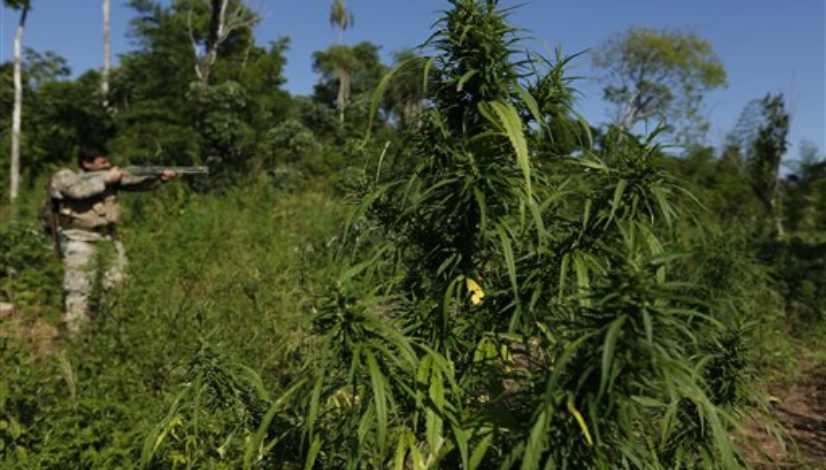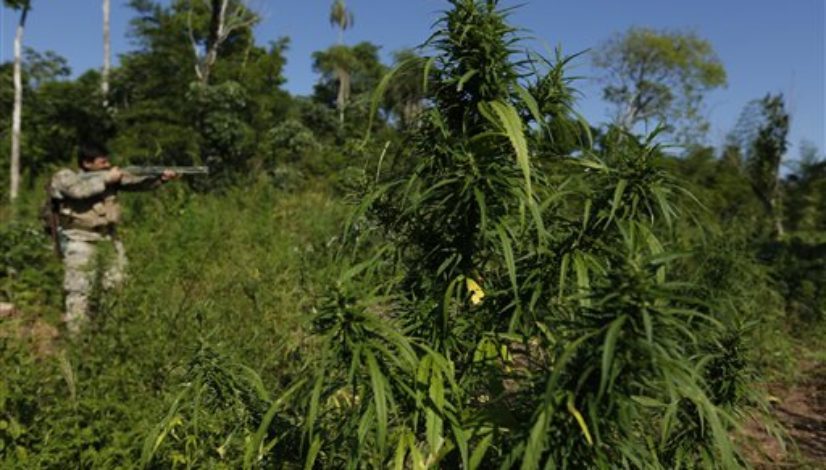Paraguay’s booming marijuana export traffic attracting gangs and violence

Published: Aug 17, 2017, 3:46 pm • Updated: Aug 17, 2017, 3:46 pm
By Max Radwin, Special To The Washington Post
CURUGUATY, Paraguay — Paraguay is a global marijuana powerhouse: The small South American country produces 9 percent of the world’s supply. But until recently, it wasn’t common there to see drug raids or hear helicopters thumping overhead in search of plantations. That’s all changing.
Last June, Paraguay’s most prominent crime lord was killed by Brazilian gang members. He left behind a burgeoning marijuana and cocaine empire that is quickly becoming one of South America’s biggest drug-trafficking headaches, and the fight to control that trade is proving far more vicious than Paraguayan officials anticipated.
With thousands of square miles of farmland, Paraguay has a stable, agriculture-based economy – and the world’s fourth-largest crop of marijuana, according to the United Nations Office on Drugs and Crime, or UNODC.
Even so, Paraguay has traditionally lacked the rampant violence and corruption that has allowed expansive drug-trafficking organizations to take hold in other parts of South America. But its porous borders and central position on the continent, among other factors, have begun to attract increasing attention from major drug gangs.
Less than one percent of Paraguay’s population consumes marijuana, according to the country’s National Anti-Drug Secretariat, or SENAD, viewing it instead as a high-risk, high-reward cash crop with a better yield than soybeans, one of the country’s main legal exports. That means nearly all of the marijuana grown in Paraguay enters the international black market, SENAD said.
Related stories
- Legal cannabis sales begin in Uruguay under landmark 2013 law
- Chile starts medical cannabis pilot program
- Uruguay opens registry for world’s first government-run marijuana market
- Argentina legalizes medical cannabis, creates research program with free access
- Global ganja: Cannabis policies rapidly evolving
Officials there said about 20 percent of Paraguay’s marijuana is shipped south to Uruguay, Argentina and Chile – each country’s main supply of the drug – or west to Bolivia. The other 80 percent crosses the border to Brazil, where it is purchased by various gangs and distributed throughout the country.
For the past two decades, most of the transactions were controlled by Paraguay’s crime lord, Jorge Rafaat Toumani, a car-tire magnate whose main client was the powerful Brazilian gang First Capital Command. SENAD officials said the gang killed Rafaat last June in the hopes of taking direct control over Paraguay’s booming drug trade.
“It’s almost as if they just now realized that the opportunity existed,” said Capt. Oscar Chamorro. “Before, they just bought the drugs and they sold them, distributed them. But they started to question why they needed to talk to a middleman.”
First Capital Command – which made headlines this year for a series of bloody prisonriots and a complex, $40 million heist in the Paraguayan city of Ciudad del Este – is not alone in its efforts to expand into Paraguay. Chamorro said a rival Brazilian gang called Red Command, in addition to various nameless crime rings from Paraguay and Bolivia, continue to jockey for control of marijuana plantations and trafficking routes.
They’re not only interested in controlling and potentially expanding marijuana operations, Chamorro said, but also the flow of cocaine entering west from Bolivia. It’s a vital thruway to Brazil, a global leader in cocaine consumption according to the UNODC, and a major entry point to the European market.
SENAD Minister Hugo David Vera Quintana told The Washington Post that Bolivian cocaine mostly arrives in Paraguay via small private aircraft, then travels into Brazil by land. Although much of that movement is controlled by First Capital Command, he said, smaller groups are now investing in the marijuana trade with plans to transition to cocaine later on, meaning trafficking activity could increase.
SENAD, in collaboration with the Paraguayan national police and Brazil’s federal police, regularly captures and destroys cars, planes and “clandestine” runways involved in both cocaine and marijuana trafficking. But Vera Quintana said the authorities are only disrupting 25 to 30 percent of the smuggling activity.
Even as SENAD has ramped up its operations – the agency has removed 2,930 acres of marijuana through the first half of this year, nearly surpassing its figures from all of 2016 – it says it is worried about falling behind the expanding drug trade. Officials find themselves returning to the same areas every six months to clear out marijuana crops again, and they say they don’t have the resources to expand operations and make a more permanent impact.
Those resources, they argue, are the issue – not strategy. In years past, officials said SENAD was able to enforce a sort of equilibrium in which their efforts were preventing a spike in marijuana output but also not drastically lowering it.
Now, with mounting gang activity, they said SENAD has to increase its budget, resources and personnel to maintain that equilibrium. At the moment, the agency has a relatively small budget of $9 million, and only 300 people to carry out both eradication operations and border patrols. SENAD officials said they plan to expand by as much as 20 percent in 2018, and could see additional growth in years to come.
“We don’t need to stop what we’re doing and find a different strategy,” said Chamorro, the SENAD officer. “We just need to get better at what we’re already doing.”
Topics: illegal farming, South America, trafficking




